The spiny-back eel, Notacanthus sexspinis, is a deep-sea spiny eel of the genus Notacanthus, found in all the Southern Hemisphere oceans at depths between 500 and 1,000 m. The length of this fish is up to 60 cm (24 in).
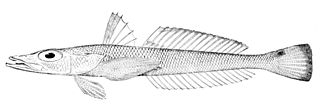
The Percophidae, duckbills, are a family of percomorph fishes, from the order Trachiniformes, found in tropical and subtropical waters of the Atlantic and Indian Oceans and in the southwestern and southeastern Pacific.
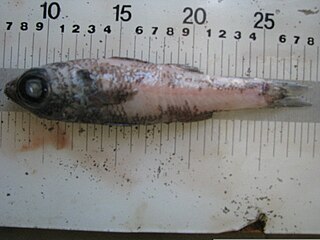
Epigonus telescopus, the black cardinal fish, is a species of deepwater cardinalfish found in most temperate oceans worldwide, at depths of between 75 and 1,200 metres though mostly between 300 and 800 metres. It can reach a length of 75 centimetres (30 in) TL though most specimens do not exceed 55 centimetres (22 in) TL. It has been reported that this species can reach an age of 104 years.

Latris lineata, the striped trumpeter, common trumpeter, copper moki, Hobart-town trumpeter, kokikohi, real trumpeter, Tasmanian striped trumpeter or Tasmanian trumpeter, is a species of marine ray-finned fish belonging to the family Latridae, the trumpeters. It is native to rocky reefs in the temperate oceans of the southern hemisphere.

Mullus barbatus is a species of goatfish found in the Mediterranean Sea, Sea of Marmara, the Black Sea and the eastern North Atlantic Ocean, where its range extends from Scandinavia to Senegal. They are fished, mostly by trawling, with the flesh being well regarded. The International Union for Conservation of Nature has assessed their conservation status as being of "least concern".

The Bear Seamount is a guyot or flat-topped underwater volcano in the Atlantic Ocean. It is the oldest of the New England Seamounts, which was active more than 100 million years ago. It was formed when the North American Plate moved over the New England hotspot. It is located inside the Northeast Canyons and Seamounts Marine National Monument, which was proclaimed by President of the United States Barack Obama to protect the seamount's biodiversity.

The longnose stingray is a species of stingray in the family Dasyatidae, native to the western Atlantic Ocean from the southern Gulf of Mexico to Brazil. Found in coastal waters no deeper than 36 m (118 ft), this demersal species favors muddy or sandy habitats. The longnose stingray is characterized by its angular, rhomboid pectoral fin disc, moderately projecting snout, and whip-like tail with a dorsal keel and ventral fin fold. It typically grows to 1.25 m (4.1 ft) across and is brownish above and light-colored below.

The vermilion snapper, the clubhead snapper, night snapper, Brian's red fish or beeliner is a species of marine ray-finned fish, a snapper belonging to the family Lutjanidae. It is native to the western Atlantic Ocean.
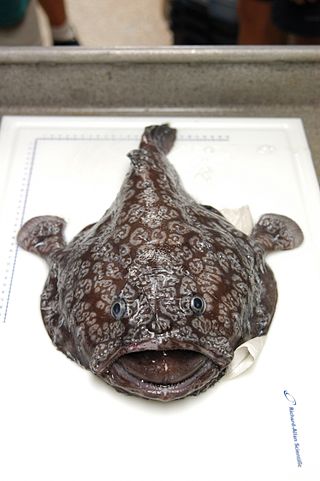
Sladenia shaefersi, the Atlantic twospine goosefish or Shaefer's anglerfish, is a species of marine ray-finned fish belonging to the family Lophiidae, the goosefishes, monkfishes and anglers. This species is found in the western Atlantic Ocean.
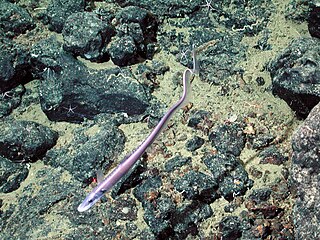
Aldrovandia is a genus of ray-finned fish in the family Halosauridae. They occur in the Pacific, Atlantic, and Indian Oceans. They can reach 55 cm (22 in) in total length.

Coryphaenoides rupestris is a species of marine ray-finned fish in the family Macrouridae. Its common names include the rock grenadier, the roundnose grenadier and the roundhead rat-tail. In France it is known as grenadier de roche and in Spain as granadero de roca. It is a large, deep-water species and is fished commercially in the northern Atlantic Ocean.
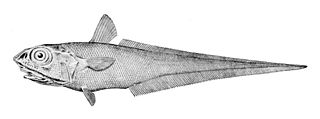
Macrourus berglax, also known as the roughhead grenadier or onion-eye grenadier, is a species of marine ray-finned fish in the family Macrouridae. It is a deep-water fish found in the Atlantic Ocean.
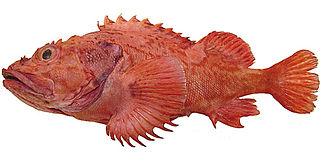
Adelosebastes is a monotypic genus of marine ray-finned fish belonging to the subfamily Sebastinae, the rockfishes, part of the family Scorpaenidae. The only species in this genus is Adelosebastes latens, the Aleutian scorpionfish. It is found in the northern Pacific Ocean.

Nemipterus bipunctatus, the Delagoa threadfin bream, Bleeker's threadfin bream or butterfly bream, is a species of marine ray-finned fish belonging to the family Nemipteridae, the threadfin and whiptail breams. This demersal fish is found over soft bottoms in the Indian Ocean.
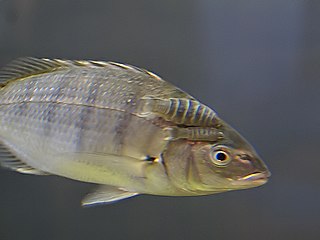
The west coast seabream or west coast steenbras is a species of marine fish in the family Sparidae. It is found in very shallow water off the coasts of to Angola, Namibia and South Africa. The International Union for Conservation of Nature lists its conservation status as being "near threatened".

Parapercis alboguttata, the bluenose grubfish, known also as the bluenose sandperch and whitespot sandsmelt, is a species of marine bony fish in the family Pinguipedidae, native to the western Indo-Pacific Ocean. It was first described by the German-born, British ichthyologist and zoologist, Albert Günther, in 1872.
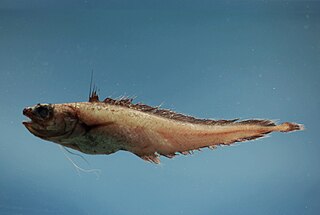
The short beard codling is a species of marine bony fish in the family Moridae. Native to the western Atlantic Ocean, it is found on the continental slope at depths between 50 and 1,620 m.
Gerres nigri, the Guinean striped mojarra is a species of mojarra native to the eastern Atlantic Ocean. It inhabits estuaries, coastal waters and lagoons. This species can reach a maximum length of 20 cm (8 in), with 15 cm (6 in) being a more common size.

Odontoscion dentex, the reef croaker or brown large-eyed croaker, is a species of marine ray-finned fish belonging to the family Sciaenidae, the drums and croakers. It is found in coral and rocky reefs of the tropical Western Atlantic, living as solitary individuals or in small groups at a depth of 1 to 30 m. This species feeds on small fish, shrimp, and larvae.
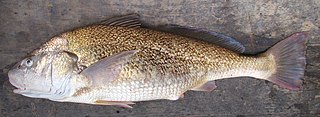
Micropogonias furnieri, the whitemouth croaker, golden croaker, hardhead, mangrove snapper, rocandoronco, two-belly bashaw, West Indian croaker, West Indian drum or whitemouth drummer, is a species of marine ray-finned fish belonging to the family Sciaenidae, the drums and croakers. This fish is found in the western Atlantic Ocean.



















